Small sedans are less “in” than they used to be. Which may be why Mazda offers its smallest sedan – the 3 – another way.
You have your pick of sedan – or five-door hatchback. Both are essentially the same 3 – presented in two different forms. One costs less – and has less room, for cargo – because it’s a sedan and has a trunk. The other costs a little more – and gives you more room for cargo – because its got a hatchback rather than a trunk.
It’s also available with a manual transmission – and all-wheel-drive. The sedan offers AWD, too – but not the manual. But you pay less for it – including with AWD.
As the saying goes, you pays your money and you takes your choice!
The Mazda3 is a compact-sized sedan – or five-door hatchback – that competes with others in the class such as the Toyota Corolla, Honda Civic and Hyundai Elantra. It emphasizes style and athletic handling, along with the option to pick the body-style that suits you.
Plus some other things.
Prices for the sedan start at $20,800; the five-door hatchback’s starting MSRP is $22,750. In addition to the sedan’s lower starting price, it also comes standard with a less powerful 2.0 liter engine while the hatch comes standard with a larger – and stronger 2.5 liter engine, which is also optionally available in the sedan.
Both versions of the 3 are also available with a turbocharged version of the 2.5 liter engine that is the second-strongest available engine in the class.
And the strongest you can get in this class . . . in a hatch.
The sedan version offers it for $30,550 to start. The same engine in the hatch stickers for $31,550.
You can get AWD either way, too.
As well as a manual transmission – with the hatch (but not with the sedan).
A top-of-the-line Premium Plus version of the hatch (with the 2.5 turbo engine and AWD) stickers for $34,400 but you can get the same drivetrain, sans the hatch, for $33,100 if you choose the sedan version of the 3. 
What’s New
For the 2022 model year, Mazda has added a Carbon Edition to the roster of options. It is chiefly an appearance package that bundles gray exterior paint with black exterior accents and red leather-trimmed interior. If you choose this option you’ll also get an upgraded 12 speaker Bose premium audio system.
What’s Good
Choose your style – and your price.
Multiple engine/transmission and drivetrain choices.
One of the most enjoyable to drive cars in the class.
What’s Not So Good
Sedan is automatic-only.
LCD interface for the audio system is fussier-to-use than rivals’ systems.
Outward visibility in the hatch is less than in the sedan.
The sedan version of the 3 comes standard with a 2.0 liter four cylinder engine that makes 155 horsepower; it’s paired exclusively with a six speed automatic transmission and front-wheel drive.
Optional – in the sedan – and standard in the hatch – is a larger, 2.5 liter engine that makes 186 horsepower, making it one of the strongest optional (and standard) engines in the class.
It’s available with a six speed manual transmission – in the hatch.
Or you can choose the optional six speed automatic, which is standard in the sedan. Which is automatic-only. Why Mazda limits the availability of the manual to the hatchback probably has something to do with that version of the 3 being perceived as the sportier version of the two (Honda also offers the Civic with a manual – but likewise, not in the sedan.)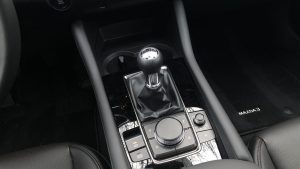
But the upside is, it’s available.
And there’s another upside, too.
The automatic that’s available (and standard, in the sedan) is also a six speed transmission. Read that again. Six gears – not eight or ten of them, like many current automatics. Why is having fewer gears an upside? Because it means fewer shifts and less constant shifting, which means a less “busy” transmission and also one that will probably last longer, being simpler.
Fewer parts – fewer problems.
Automatics with eight or nine or ten speeds have multiple overdrive gears, each designed to “step down” engine RPM and to allow for a very deep final overdrive gear, without lugging the engine on the way there. All of this provides a slight fuel economy benefit, important not so much to you, the buyer, but to the company trying to sell you the car – and “comply” with government fuel-economy mandatory minimums. 
That’s also why so many cars in this class that have automatics have continuously variable (CVT) automatics, with no gears at all.
But how much is gained, MPG-wise?
The 3 sedan with the 2.0 engine and six speed automatic posts 28 city, 36 highway. The Toyota Corolla, with its standard 1.8 liter engine and CVT automatic rates 30 city, 38 highway. The Honda Civic – with a same-sized 2.0 liter engine and CVT automatic – rates 31 city, 40 highway.
It’s a difference – but not an epic one.
And while gas prices are becoming more of a concern with every passing day – Let’s Go Brandon! – another relevant concern is the durability/longevity of CVT and multiple-overdrive automatic transmissions. Their track record isn’t nearly as good as that of simpler automatics with just six gears – and no metal bands to fatigue-snap, as sometimes happens with CVTs.
This is especially relevant given the replacement cost of any modern automatic transmission, which is generally on the order of $3,000 or more. That being especially relevant when we’re dealing with economy cars, which are worth less than other cars after eight or ten years because they cost less to start than other cars, when they were new. It’s not favorable math when you have a ten-year-old economy car with a retail market value of $6,500 that needs a $3,000 transmission replacement.
Mazda also offers all-wheel-drive as an option – in both the hatch and the sedan. But only with the automatic transmission. 
There’s one more engine option, too.
If you want to own the strongest – and quickest – hatch in this class, choose the turbocharged version of the 2.5 liter four cylinder engine.
Feed it premium unleaded and the computer will dial up maximum boost – and 250 horsepower. That’s 50 more horsepower than the maximum-effort Honda Civic Si offers (200) and which is only offered in the sedan version of the Civic.
The N version of Hyundai’s Elantra offers more horsepower (276) but – like the Civic – only in sedan form.
Which means you get more power – but less practicality. 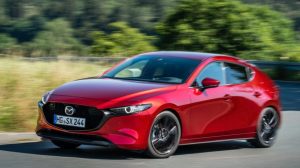
On The Road
Economy cars used to be just that. They got good gas mileage – and they didn’t cost you much.
The 3 is more than just that.
It is economical – and enjoyable. Especially the hatch, because of its very strong (for the class) standard 2.5 liter engine and the available manual transmission to go with it. This engine likes to rev – peak horsepower is achieved at 6,000 RPM – and the manual gives you full control over it.
On the downside, outward visibility is not-so-great in the hatch; the side glass is short relative to tall doors while the hatchback shape narrows the view to the rear. The view of the outside world from inside the sedan is much better, in part because there is more side-glass area (especially as regards the rear door glass, which there is more of than the driver/passenger side door glass) and the larger rear glass.
Mazda does its usual superlative job when it comes to balancing ride quality with corner-carving ability. The 3 – both versions – is one of the best-handling cars in the class and is also, arguably, one of the most comfortable cars in the class.
This is harder than it looks.
To reduce body roll and sharpen up steering feel is easy; you just cinch down the suspension and slap on some short-sidewall tires. But it’s not so easy to tamp down the reverb effect of pothole strikes and road noise/drone from those short-sidewall tires and not have a car that rolls in the curves.
Mazda gives you the handling without the beating-up better than an anyone else.
It’s nice to be able to choose the suit that . . . suits.
The hatch offers more practicality – more than three times as much space for cargo (47.1 cubic feet) than the sedan (13.1 cubic feet) at the price of some visibility – per above comments.
The hatchback layout not only offers more space, it opens up the space available. The opening is wider and you can use the entirety of the car’s interior to fit things that would never fit in the sedan.
On the other hand, if you don’t need the extra space – and prefer not to pay for it – the sedan’s got you covered. The increased visibility’s free, too. 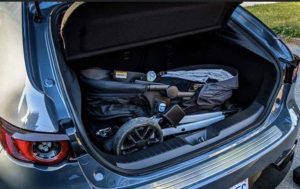
Both versions have the same very generous driver/front seat passenger legroom (42.3 inches) and par-for-the-class 35.1 inches of legroom for the backseat riders.
The interior layouts are also the same – which is good, because Mazda excels at designing interiors that are smart-looking and functioning. The 3 has a Miata-like main instrument panel with round, analog-style gauges that are electrically back-lit. They are easy to read at a glance and do not distract you with gadgetry that may look good on the showroom floor but isn’t so good in terms of keeping your eyes on the road.
The one departure from this otherwise appealing ensemble is the interface for the stereo and some of the other controls – but thankfully not the climate controls. The AC/heat/fan are controlled by straightforward knobs and buttons that can be used by feel or at a glance. But the stereo is controlled by a rotary mouse-thing on the center console that you push to select things after moving it left-right/up-down to select other things. It makes a simple thing like changing the station not-so-simple.
It’s the one thing about this car – sedan and hatch – that isn’t better than what the competition offers.
The Rest
This “economy” car comes standard with rain-sensing wipers, LED headlights, adaptive cruise control, remote vehicle monitoring and an eight-speaker stereo rig. There was a time – and not so long ago – when you had to buy a Cadillac or a BMW to get such equipment.
You can also get multi-stage heated leather seats, adaptive headlights that follow the curves and a 12 speaker audio system.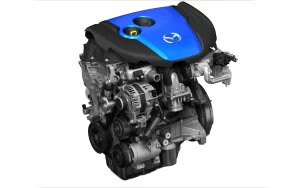
The one thing you can’t get is a diesel engine – the engine which Mazda had planned to offer by now in several models, including the 3 – but which is off the roster, probably forever, on account of the federal government’s regulatory insistence on more than partial zero emissions (PZEV). This is a standard which no diesel engine can “comply” with and which a dwindling number of gas engines can comply with. Which is just what the regulations are meant to do – in order to make it all-but-impossible to build anything that isn’t a “zero emissions” electric car – in air-fingers-quotes to emphasize th fact that EVs aren’t that.
They simply “emit” elsewhere.
The Bottom Line
It’s a shame about the limited availability of the manual – but green lights as far as just about everything else!
. . .
Got a question about cars, bikes or anything else? Click on the “ask Eric” link and send ’em in! Or email me at EPeters952@yahoo.com if the @!** “ask Eric” button doesn’t work!
If you like what you’ve found here please consider supporting EPautos.
We depend on you to keep the wheels turning!
Our donate button is here.
If you prefer not to use PayPal, our mailing address is:
EPautos
721 Hummingbird Lane SE
Copper Hill, VA 24079
PS: Get an EPautos magnet or sticker or coaster in return for a $20 or more one-time donation or a $10 or more monthly recurring donation. (Please be sure to tell us you want a magnet or sticker or coaster – and also, provide an address, so we know where to mail the thing!)
My eBook about car buying (new and used) is also available for your favorite price – free! Click here. If that fails, email me at EPeters952@yahoo.com and I will send you a copy directly!


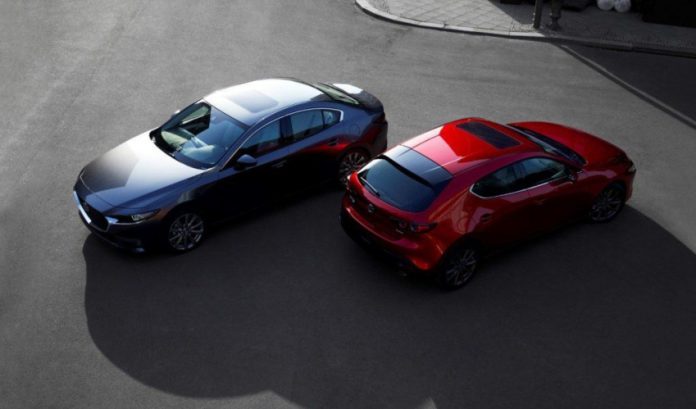













Daughter #1 has had two 3s and now a 6, all have been reliable fun to drive with no fuss or bad manners.
The early Ford Escapes were a collaboration with Mazda (Tribute), it shows in what a reliable great driving rig my 2003 Escape has been. Literally the go-cart of small SUVs for crisp steering.
These seem pretty pricey to be honest. 35k for top of the line, yikes. I know they are nice, but still. That’s a lot of money for what is, a small car. If 25k was the top of the line, they would be selling way more IMHO.
It’s no wonder cars don’t sell anymore.
My folks picked up a 2018 Ford Focus in 2019 for half off the MSRP. It was one of three on the lot of a high volume dealer. It sat unsold for nearly two years because nobody wanted it at that price. Even at this, one of Fords highest volume dealers! At the “half off” price it’s a great value, they would have never touched it at full price. So the main problem with small cars is the price. They aren’t less enough over those crossovers. Even when you can’t get a deal on the crossover.
Eric, re: 8-10 speeds.
You’re right, have a newer Ram w.8sp and 3.21 rears, it rarely goes to 7th and 8th, and if it does it’s under the lightest of loads, like down hill. What a waste. But I’m sure it has something do with CAFE to squeeze out another 1/2 mpg using their testing standards. I am a heavy foot most of the time.
So I needed another truck in a different location. I bought the same exact truck, but this time with the optional 3.9 rears. It’s so much better. Stays in 8th up and down hills, etc… rarely going to 7th. Yeah it tachs up a little more at highway speeds, don’t care. And here’s the kicker, the 3.9 geared truck gets 1-2 more mpg. go figure.
Sorry this isn’t about the mazda. Great car.
Rain sensing wipers. Like you’re too fucking dumb to know when to click the wiper button. In Critical Drinker voice ugggggghhhhhhhh
did my emoji face change?
close enough
I turned mine off
Sigh. I saw “For the 2022 model year, Mazda has added a Carbon Edition…” and was expecting to hear they’d done some goofy carbon credit default swap option package for the Mazda 3! I should stop reading the news.
Toyo Kogyo always marched to the beat of a different drummer in the old days. Good to hear they still do, with available 2.0L and 2.5L engines. Wish VW still had the family car reliable 2.5L Five. Also wish Mazda still had that little rotary pickup, that was one sweet little ride.
Still holding out for the Turbo Triple Rotary. 😉
Me also, Mike –
But I don’t think it’s going to see the light of day. Too many “emissions” … not enough MPGs.
Thank Uncle. Thank people who like him.
How ’bout a Hybrid Turbo Triple Rotary? 🙂
Like your review.
Agree with you about rear visibility of the hatchback.
Off topic: (I have little idea about costs or practicality involved, just some questions)
There are more demands for ever higher mpg levels to avoid financial penalties (to be paid by the buyer if vehicle is even offered) from bureaucratic ukase.
Why are vehicles not built with lighter materials and/or designs? Even if it costs more, the extra cost might not matter as much since those in power are mandating higher costs by ukase.
I was thinking about the caterham type car or Nascar type.
Cars can be built lighter and safer.
A lighter vehicle can be more fuel efficient and require a smaller engine to get around town. It still can have an acceptable level of safety.
Do not know about difficulty in working/repairing different materials or how easy it is to design/create new lighter materials that can create vehicles.
(All things being equal heavier bigger vehicles will be easier to make safer than smaller lighter vehicles. But isn’t it possible and practical enough to make a lighter vehicle that is safe enough? And should it not be left to the individual to decide what is safe enough for themselves? )
Maybe this might be worth an article.
Thanks, Mith!
The problem with weight/materials is essentially as follows:
Government “safety” regs have to be met; the only cost-effective way to do so is by adding structure – which adds weight. Lighter weight/high strength materials are available – e.g., carbon fiber – but they are expensive and if people can’t afford to buy the car…
Suspected something along those lines. As it has been said before: The goal is to reduce/eliminate freedom of mobility.
I bought a 1999 Corolla with a manual transmission back in 2008 when gas started going up, and loved that car. It had 225,000 miles when I got rid of it, never had to work on it at all. It was made in Japan, apparently they still take pride in their work over there, all my American made vehicles have had problems. So, I bought a new 2014 Mazda3 (6 speed auto, sadly), which was also made in Japan, and now have 123,000 miles on it and have never had to work on it, either. Oh, and it gets over 41 MPG, odd how the new models that are made in Mexico can’t match its fuel mileage. I had thought about getting a CX-5, but with gas near $4, I’m glad I didn’t.
great write up. Looked at these before but couldn’t find any we wanted on the used market.
Thanks for the kind words, Dan!
I think the most fun – and sense – is currently in the entry-level segment. Among the chief reasons being you can still get several of these cars (like the 3) with a manual…
seems like that is the case
“You have your pick of sedan – or five-door hatchback”
I just wish they would keep the length of both the sedan and hatchback the same.
I wanted to add “They should keep the hatchback the same length 183 inches as the sedan:.
BTW the local gas station ( Chit****go) has gas prices as follows; reg $4.50 premium $5.50.
WTF!!!
Itz good that the Mazda turbo can run on regular but at slightly reduced power. Zero to 60 claims 5.6 sec to 60 That’s hot rod territory.